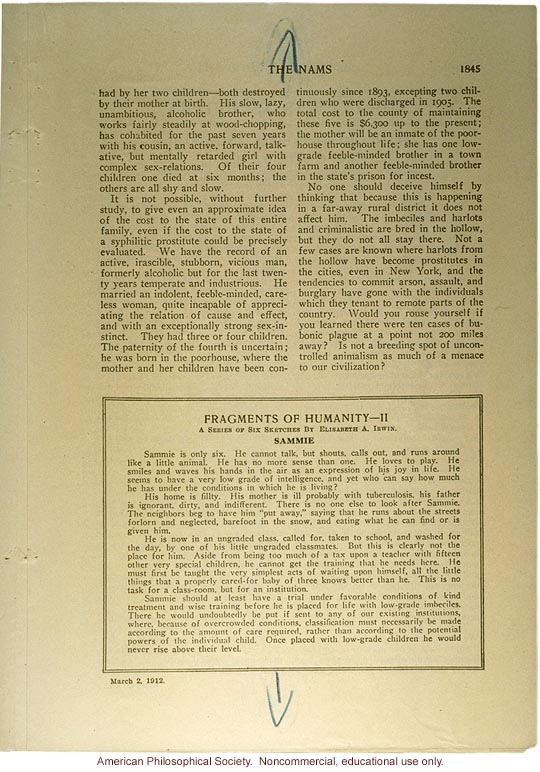The Nams
1845
had by her two children - both destroyed by their mother at birth. His slow, lazy, unambitious, alcoholic brother, who works fairly steady at wood-chopping, has cohabited for the past seven years with his cousin, an active, forward, talkative but mentally retarded girl with complex sex-relations. Of their four children one died at six months; the others are all shy and slow.
It is not possible, without further study, to give even an approximate idea of the cost to the state of this entire family, even if the cost to the state of a syphilitic prostitute could be precisely evaluated. We have the record of an active, irascible, stubborn, vicious man, formerly alcoholic but for the last twenty years temperate and industrious. He married an indolent, feeble-minded, careless woman, quite incapable of appreciating the relation of cause and effect, and with an exceptionally strong sex-instinct. They had three or four children. The paternity of the fourth is uncertain; he was born in the poorhouse, where the mother and her children have been continuously since 1893, excepting two children who were discharged in 1905. The total cost to the county of maintaining these five is $6,300 up to the present; the mother will be an inmate of the poorhouse throughout life; she has one low-grade feeble-minded brother in the state's prison for incest. No one should deceive himself by thinking that because this is happening in a far-away rural district it does not affect him. The imbeciles and harlots and criminalistic are bred in the hollow, but they do not all stay there. Not a few cases are known where harlots from the hollow have become prostitutes in the cities, even in New York, and the tendencies to commit arson, assault, and burglary have gone with the individuals which they tenant to remote parts of the country. Would you rouse yourself if you learned there were ten cases of bubonic plague at a point not 200 miles away? Is not a breeding spot of uncontrolled animalism as much of a menace to our civilization?
Fragments of Humanity -- II
A Series of Six Sketches by Elizabeth A. Irwin.
Sammie
Sammie is only six. He cannot talk, but shouts, calls out, and runs around like a little animal. He has no more sense than one. He loves to play. He smiles and waves his hands in the air as an expression of his joy in life. He seems to have a very low grade of intelligence, and yet who can say how much he has under the conditions in which he is living?
His home is filthy. His mother is ill probably with tuberculosis, his father is ignorant, dirty, and indifferent. There is no one else to look after Sammie. The neighbors beg to have him "put away," saying that he runs about the streets forlorn and neglected, barefoot in the snow, and eating what he can find or is given him.
He is now in an ungraded class, called for, taken to school, and washed for the day, by one of his little ungraded classmates. But this is clearly not the place for him. Aside from being too much of a tax upon a teacher with fifteen other very special children, he cannot get the training that he needs here. He must first be taught the very simplest acts of waiting upon himself, all the little things that a properly cared-for baby of three knows better than he. This is no task for a class-room, but for an institution.
Sammie should at least have a trial under favorable conditions of kind treatment and wise training before he is placed for life with low-grade imbeciles. There he would undoubtedly be put if sent to any of our existing institutions, where, because of overcrowded conditions, classification must necessarily be made according to the amount of care required, rather than according to the potential powers of the individual child. Once placed with low-grade children he would never rise above their level.
March 12, 1912.


